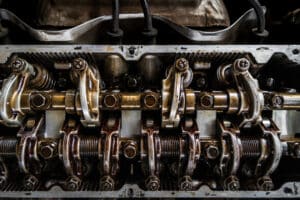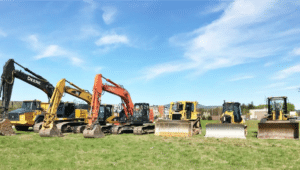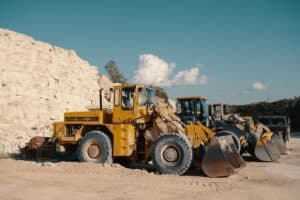Why Lifespan Matters and How It’s Measured
Every piece of heavy construction machinery tells its story in hours. That’s not just how long it’s worked, but how carefully it’s been maintained. At Sur-Flow Hydraulics & Equipment Repair, we see firsthand how a skid steer that’s regularly greased, cleaned, and serviced can easily outlive one that’s been neglected. The difference isn’t luck-of-the-draw, it’s a disciplined preventive maintenance plan supported by detailed records and manufacturer’s recommendations.
Understanding how long heavy equipment should last and what shortens that service life helps operators lower operating costs, reduce repair costs, and prevent sudden failure that can halt productivity. Having a reliable maintenance checklist keeps machinery operating safely and efficiently while preventing costly problems and damage to key components.
How Maintenance Dictates Heavy Equipment Lifespan
“Greasing is number one,” says Calvin from Sur-Flow Hydraulics & Equipment Repair. “Some components need it every 5 hours, others every 10. And don’t skip your 300-hour service.” That type of regular maintenance keeps wear on components in check and helps our technicians spot potential problems before they cause downtime.
Key Routine Maintenance Tasks
- Greasing critical joints and moving parts (every 5–10 hours)
- Engine and filter service every 300 hours (oil, air filter, and fuel)
- Hydraulic system maintenance including hydraulic oil, hydraulic fluid replacement, and air filter inspection
- Daily inspections for track tension, oil leaks, brake lights, fluid levels, and coolant levels
- Cleaning around the engine, oil cooler, and hydraulic components to prevent overheating, corrosion, and contamination
Following a structured maintenance checklist is the simplest way to keep machinery functioning properly and prevent costly problems down the road. Regular maintenance with timely service not only helps prevent leaks and fluid contamination but ensures all systems—mechanical, electrical systems, and hydraulic—stay operating at peak performance.
Typical Lifespans by Machine Type
Different machinery maintenance intervals vary depending on the machine and usage, but one rule applies to all: more preventive maintenance equals longer service life.
Mini and Compact Equipment
Skid steers, compact track loaders, and small excavators typically run 4,000–5,000 hours before major overhauls, though well-cared-for machines can reach 6,000 hours or more. You won’t find many skid steers with that kind of skid steer life expectancy unless they’ve been greased and cleaned consistently and maintained according to the manufacturer’s recommendations.
Mid-Size Equipment
Mid-size excavators and wheel loaders usually average 8,000–12,000 hours of operation. Some operators manage to stretch them to 25,000–30,000 hours, but only with detailed records, regular servicing, and a strong preventive maintenance plan that includes replacing fluids, filters, and worn hoses.
Heavy Equipment
Once you step into the 80,000+ lb class, heavy equipment like dozers, haul trucks, and large excavators can run 20,000–30,000 hours or more. Those that reach these milestones usually have a strict machinery maintenance program and dedicated technicians monitoring for oil leaks, battery connection issues, hydraulic functionality, damaged components, and more.
What Affects Equipment Lifespan the Most
Not every hour is created equal. The environment, workload, and machine operator habits all influence how long heavy equipment lasts.
- Equipment maintenance frequency: Missing oil changes or greasing schedules accelerates wear on major components and can lead to costly corrective actions.
- Operating environment: Dust, mud, and extreme temperatures cause contamination, corrosion, and fluid degradation. Our technicians often remind customers: in dusty sites, grease more often to prevent breakdown.
- Operator habits: Overloading, idling too long, or neglecting inspection steps reduces machine efficiency and increases downtime.
- Parts availability: We keep hydraulic equipment components and hoses in stock to minimize delays and keep your operation running.
- Cleanliness: Dirt and debris around the hydraulic system trap heat, leading to early component failure and reduced performance. Keeping oil levels and coolant levels within proper range helps prevent leaks and maintain efficiency.
Which Brands Are the Most Reliable? What We’ve Seen at Sur-Flow
Reliability depends not only on design but on service support. At Sur-Flow, we’ve worked on everything from Caterpillar to Deere and Case, but Caterpillar stands out for excellent parts availability, fair pricing, and timely service. Their hydraulic systems are well-engineered and easier to keep functioning properly with regular maintenance.
Having quick access to replacement parts prevents long repair delays and keeps operating costs predictable.
How to Extend the Life of Your Equipment
Every hour counts, and your habits can add years of dependable operation to your machinery.
- Stick to 300-hour service intervals or better.
- Keep your hydraulic system clean, fluid levels checked, and hoses properly aligned.
- Use high-quality hydraulic oil and replace filters regularly to prevent leaks and contamination.
- Inspect before every shift for damage, leaks, coolant levels, and loose fittings.
- Maintain tire tread and rubber tracks, keep tires inflated properly, and regularly test electrical systems to avoid downtime.
- Keep an updated maintenance checklist, and track inspection results to identify potential problems early.
- Work with a trusted hydraulic equipment repair shop like Sur-Flow for inspection, preventive maintenance practices, and diagnostic support.
Our technicians at Sur-Flow see it daily: equipment with a preventive maintenance plan runs smoother, performs at peak performance, and costs less to operate over time.
Don’t Neglect, Let Us Detect! Final Thoughts On Heavy Equipment Maintenance
Whether it’s a skid steer, dozer, or wheel loader, the secret to longevity is the same: proper maintenance, clean hydraulic systems, and preventive care. The difference between 5,000 and 30,000 hours comes down to consistency and attention to detail. If your goal is to keep your machinery operating efficiently for years to come, we can help make it happen.
Contact Sur-Flow Hydraulics & Equipment Repair today to schedule a preventive maintenance plan or discuss ongoing hydraulic system maintenance to keep your fleet in top shape. We do everything from basic equipment service to full engine rebuilds, and are conveniently located in Honey Brook, PA. Give us a call to learn more!

FAQs
How many hours is too many for an excavator?
Most excavators start showing wear between 8,000 and 12,000 hours, though well-maintained units can reach 20,000 or more.
What is the average lifespan of a skid steer?
A skid steer typically lasts around 4,000–5,000 hours, but regular maintenance can extend its life expectancy beyond 6,000.
Is 4000 hours a lot on a skid steer?
It depends on the maintenance history. If hydraulic system maintenance, greasing, and oil changes were done on schedule, 4,000 hours can still be midlife.
How often should hydraulic fluid be changed?
Most hydraulic systems require new hydraulic fluid every 1,000–2,000 hours, though this can vary depending on workload and conditions.
What’s considered high hours on a bulldozer?
Anything over 10,000 hours is typically considered high for a dozer, though well-maintained units with strong hydraulic equipment can surpass that.
Which heavy equipment brand lasts the longest?
From our experience, Caterpillar machines hold up exceptionally well thanks to durable components, well-designed systems, and strong parts support.
How can I make my heavy equipment last longer?
Follow a preventive maintenance plan, monitor fluid levels closely, and rely on professional technicians for inspections and service. Regular maintenance and clean hydraulic systems are the key to long-term reliability.



